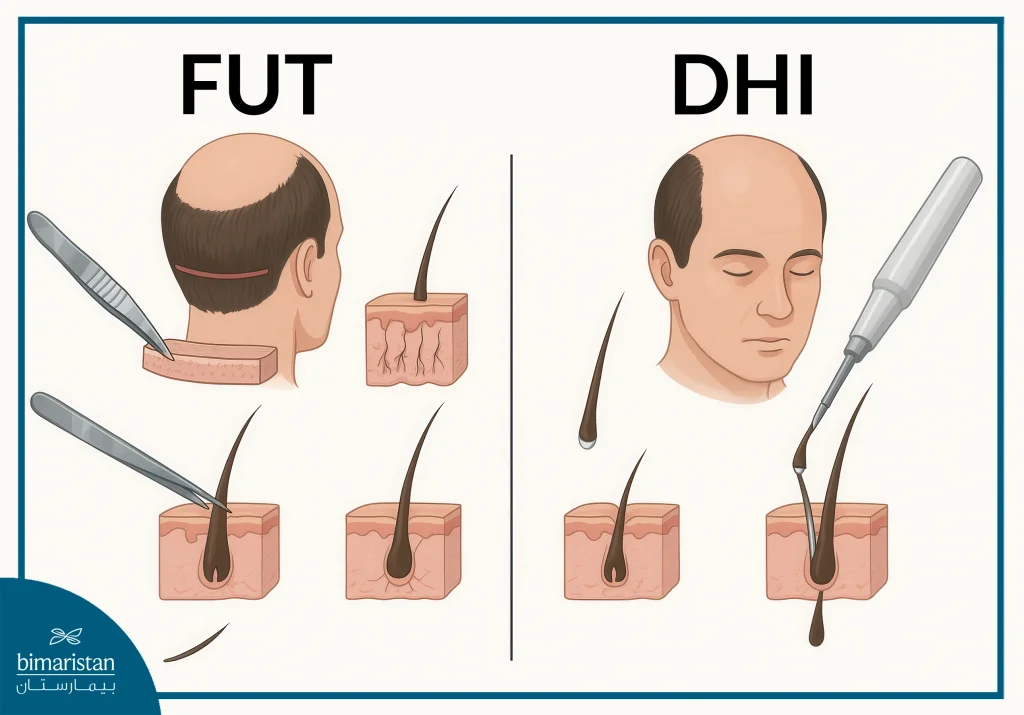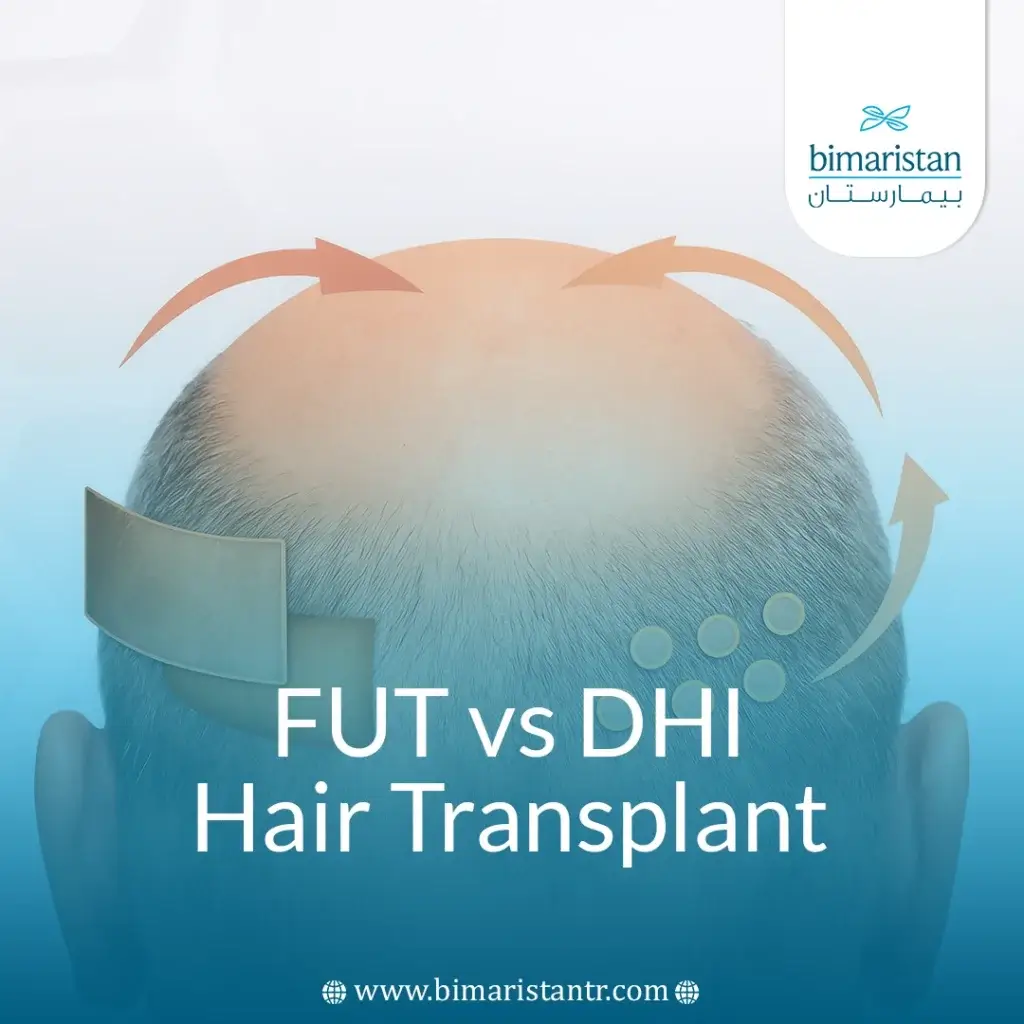FUT vs DHI hair transplant has become a common topic among patients seeking solutions for hereditary baldness and chronic hair loss. With the advancement of techniques, FUT (Follicular Unit Transplant) and DHI (Direct Harvesting Injection) are now the two main methods. Many patients wonder: What is the difference between FUT and DHI?
As interest in hair transplantation grows, understanding FUT vs DHI hair transplant is essential to compare the steps of each method, scar appearance, recovery time, expected density, and the cost of each procedure.
What is a Follicular Unit Transplant (FUT)?
Follicular Unit Transplant (FUT): Also known as the strip method, FUT is a surgical hair restoration technique that involves removing a thin strip of skin with a scalpel from the back or sides of the scalp, where hair follicles are usually healthy and strong, and hair growth is not affected by genetic baldness. The incision is usually several centimeters long.
The doctor closes the incision using advanced suturing techniques to minimize scars, such as sutures, which are usually removed 7 to 10 days after surgery.
The grafts are prepared by separating a strip of skin into individual follicular units under a microscope, and each unit contains one to four hairs to ensure a natural appearance. The grafts are transplanted by making small incisions in the bald area, taking into account how natural hair grows and the desired density.
The procedure takes approximately 4 to 8 hours, depending on the number of grafts needed, and the patient can go home the same day.
The hair begins to grow and show results during the third to fourth month, and the full result is completed during the sixth to twelfth month.
What is DHI hair transplant technology?
Direct Harvesting (DHI): A development of the traditional FUE technique, it is a non-surgical method of hair restoration in which hair follicles are detached from the donor area and transplanted directly into the hairless area without the need to open channels beforehand, making it a more precise and sophisticated technique.
The technique utilizes a proprietary device known as the Choi Pen, a hollow-needle device used to implant the follicles directly into the scalp.
The importance of this technique is that it allows opening the canal and implanting the graft at the same time, which reduces the operation time and increases its accuracy. DHI technology has evolved and is characterized by the fact that it does not require a prior canal opening procedure, as was used in the traditional FUE technique, as the grafts are directly implanted using a Choi pen, which reduces bleeding and damage to surrounding tissues and speeds up recovery.
Compare and contrast the differences between FUT vs DHI hair transplant
In order to determine the best FUT vs DHI hair transplant technique, several factors must be considered, as the following table shows the difference between hair transplantation by slice and DHI:
| Criterion | FUT (Flip-Up Technique) | DHI (Direct Harvesting) |
|---|---|---|
| Picking method | Removing a whole slice of skin | Picking one bulb at a time |
| Scar shape | A thin, linear scar visible on the back of the head | Very fine, almost invisible scars |
| Recovery time | Relatively longer, needing 7 to 10 days | Faster and less hassle |
| Planting density | Suitable for large spaces | Precision farming is ideal for small spaces |
| Cost | 10% to 20% less expensive than DHI technology | Higher cost due to advanced tools and technology |
Which technology is best suited for your case?
- Depending on the area of baldness: If the area of baldness is large, FUT may be a suitable option because it collects a large number of grafts at once from the donor area. Smaller areas such as the front of the head or gaps between hairs are suitable for DHI because each graft can be precisely transplanted.
- Hair type and thickness: Results vary depending on the type of hair, as thicker hair usually gets better results, as each follicle contributes to a wider coverage of the bald area compared to thin hair. Therefore, DHI is preferred for thin or fine hair, as it allows for precise follicle implantation and improved optical density distribution.
- Budget: FUT is usually less expensive, while DHI is the most expensive due to the advanced tools used (such as Choi pens) and more time needed to transplant one bulb at a time.
- Recovery time: If you need to heal and return to daily life quickly and don’t want to stay too long, DHI is more suitable, while FUT has a longer recovery time (7 to 10 days).
- Consult your doctor before making a decision: The doctor will determine the most appropriate technique depending on the type of hair, area of baldness, and budget.

Hair transplant results with both methods
To choose the best technique, you should consider the success rate of each technique and know when the results will appear, and the following table shows this:
| Element | Follicular Unit Transplant (FUT) | DHI Hair Transplant |
|---|---|---|
| Success rates | The procedure can be as close as 100% when performed by an experienced medical team | Up to 100% in specialized centers such as Bimarestan |
| When to start seeing results | After 3-5 months, the hair gradually begins to grow | Results begin to appear gradually and are complete in 8-12 months |
Can the two methods be combined in some cases?
The doctor can combine FUT and DHI techniques in some cases, depending on the doctor’s assessment of the patient’s scalp, as in some cases the patient may need multiple sessions separated by several months to achieve the desired density, and the type of technique is chosen for each area of the scalp, which allows the possibility of combining the two methods to reach the best possible result.
In conclusion, the difference between FUT vs DHI hair transplant is not only about the technique, but about choosing the most suitable option for you in terms of hair type, budget, and desired results. FUT may be effective for those with extensive baldness needing a large number of grafts at a lower cost, while DHI is ideal for those seeking precise transplantation with faster results and shorter recovery. Consult your medical professional for a comprehensive assessment to determine the best choice for optimal results.
Sources:
- Sethi, P., & Bansal, A. (2013, April-June). Direct hair transplantation: A modified follicular unit extraction technique. Journal of Cutaneous and Aesthetic Surgery, 6(2), 100-105.
- MedlinePlus. (n.d.). Hair transplant. National Library of Medicine. Retrieved July 2025, from
